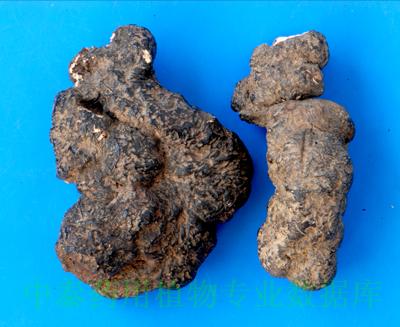| [English Name] | Agaric | |
| [Chinese Name] | 猪苓 | |
| [Pinying Name] | Zhuling | |
| [Latin Name] | Polyporus | |
| [Genera] | Polyporaceae | |
| [Efficacy] | Damp-clearing drug | |
| [Pictures] | Plant picture | Drug picture |

|

|
|
| [Alias] | ||
| [Source] | ||
| [Plant morphology] | ||
| [Distribution] | ||
| [Gathering and processing] | ||
| [Characteristics] | ||
| [Ecology] | Agaric has characteristics of preferring cold cool、gloomy、moist and resistanting to drought.It grows in apricus moutains with slope between 20 to 50°、the soil with rich humus in forest at the altitude between 1000 to 2000 metres. | |
| [Chemical composition] | ||
| [Pharmacological activities] |
1. Effect on Immune Function: Water extract can strengthen cellular immunity and inhibit humoral immunity[1]. Grifola polysaccharide can strengthen macrophages phagocytize activity[2], adjust cellular immunity[3-5]. In addition, it can increase mouse peritoneal macrophage NO level[6]. 2. Anticancer: Grifola different extract show inhibit cancer cell proliferation on S180, U14 and hepatocarcinoma[1,10]. Grifola polysaccharide show anticancer activity on mice S180and H22 model through adjust immune function[8-12]. It can inhibit bladder cancer in citro[13,14]. 3. Hepatoprotection: Grifola polysaccharide show hepatoprotection on hepatic injury mice model induced by carbon tetrachloride, D-galactosamine and hepatitis B through adjust immune fountion[15-19]. 4. Diuresis: Water extract show diuresis action on rabbit, dog and rat model through inhibit tubular reabsorption[19-21]. 5. Antibiosis: Alcohol extract show inhibit effect on staphylococcus aureus and escherichia coli[22,23]. |
|
| [Clinical trial] | ||
| [Properties] | ||
| [Medical and other Uses] | ||
| [Dosage] | ||
| [Cautions] | ||
| [Traditional usage] | ||
| [Toxicological studies] | ||
| [Pharmaceutical preparations] | ||
| [References] |
Pharmacologic Actions: [1] Pharmacology of Oncology Institute of [2] Immunity Class of Chinese Material Medica Institute, Academy of Traditional Chinese Medicine. Journal of Traditional Chinese Medicine, 1979,(3):51. [3] Wang Dechang. Chinese Traditional and Herbal Drugs, 1983,14(6):257. [4] Zhang Wandong, Lv Cheng, Zhao Hongyan, et al. Chinese Journal of Cellular and Molecular Immunology, 2007,23(9):867. [5] Li Taiyuan, Tian Guangyan, Xu Guangbo, et al. Chinese Journal of Veterinary Science, 2007,27(1):88. [6] Chen Weizhu, Hou Gan, Zhang Haitao. Journal of [7] Neoplasms Group of Chinese Material Medica Institute, Academy of Traditional Chinese Medicine Journal of Traditional Chinese Medicine, 1979,(2):15. [8] Yi Xijun. [9] [10] [11] Dongzhimen hospital and [12] Wu Guoli, She Jianchu, Yan Benjun, et al. Journal of [13] Zeng Xing, Zhang Guolai, Mei Yuping, et al. Chinese Journal of Clinical Oncology, 2003,30(2):81. [14] Wu Guoli, She Jianchu, Wei Qun, et al. Basic & Clinical Medicine, 1984,(Z1):99. [15] Zhang Yinghua, Liu Yulan, Yan Shuchang. Modern Journal of Integrated Traditional Chinese and Western Medicine, 1991,11(04):225. [16] Lin Yunfu. Acta Pharmacologica Sinica, 1988,9(4):345. [17] Lin Yunfu, Wu Guoli. Pharmacology and Clinics of Chinese Materia Medica, 1989,5(03):37. [18] Yan Shuchang, Cao Wangfang, Zhang Yinghua, et al. Chinese Journal of Integrated Traditional and Western Medicine, 1988,8(3):141. [19] Deng Zufan, Wang Shuxian. National Medical Journal of [20] Wang Liwen, Su Chengye, Liu Guoxiong, et al. Acta Pharmaceutica Sinica, 1964,11(12):815. [21] Feng Qirong, Kang Bai.Traditional Chinese Medicinal Research, 2007,20(4):25. [22] Journal of Pharmacy( [23]Kvbo H, et al. C A, 1954. 48:810i. |
|